Family : Corvidae

Text © Dr. Gianfranco Colombo

English translation by Mario Beltramini
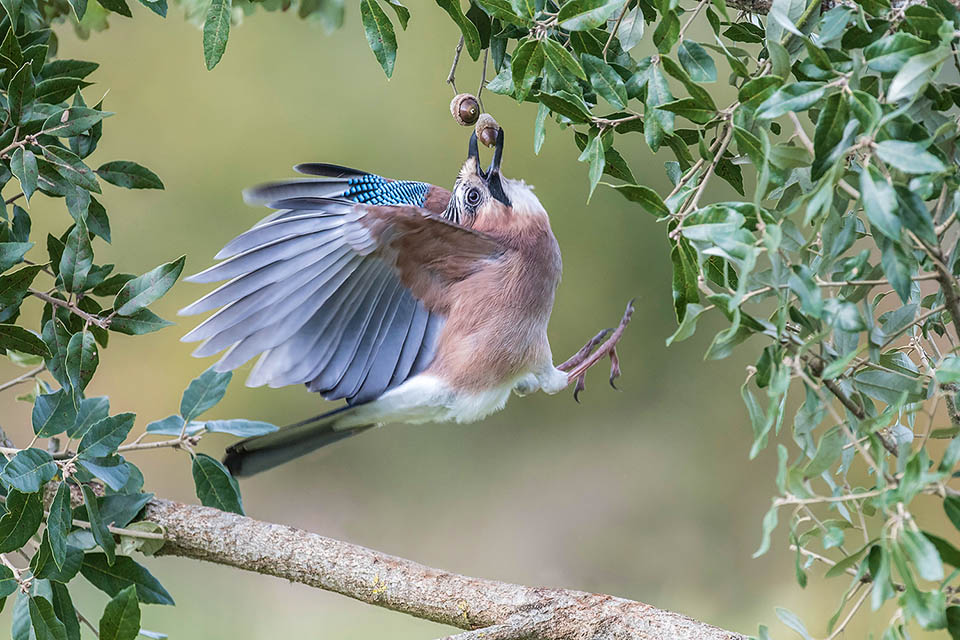
Palearctic with about thirty subspecies, the Jay (Garrulus glandarius) is a dressed-up crow with a fondness for acorns © Phil Winter
Among the corvids, the Jay is surely one of the species with the liveliest plumage and with the liveliest attitudes but is also that having the most shy and reserved character. This does not mean that these two characteristics do distinguish it in a positive sense from all its other peers of the Palearctic, usually black or blackish in the livery and even arrogant and abusive in the behaviours with the other birds.
Well we know that many members of this family are necrophagous, with some species even specialized in this activity but also the Jay does not disdain in eating carrions of dead animals!
Many corvids are aggressive and voracious and rob nests and pulli of smaller and helpless small birds, for nourishing their nestlings but also the Jay performs this activity regularly, without any qualms!
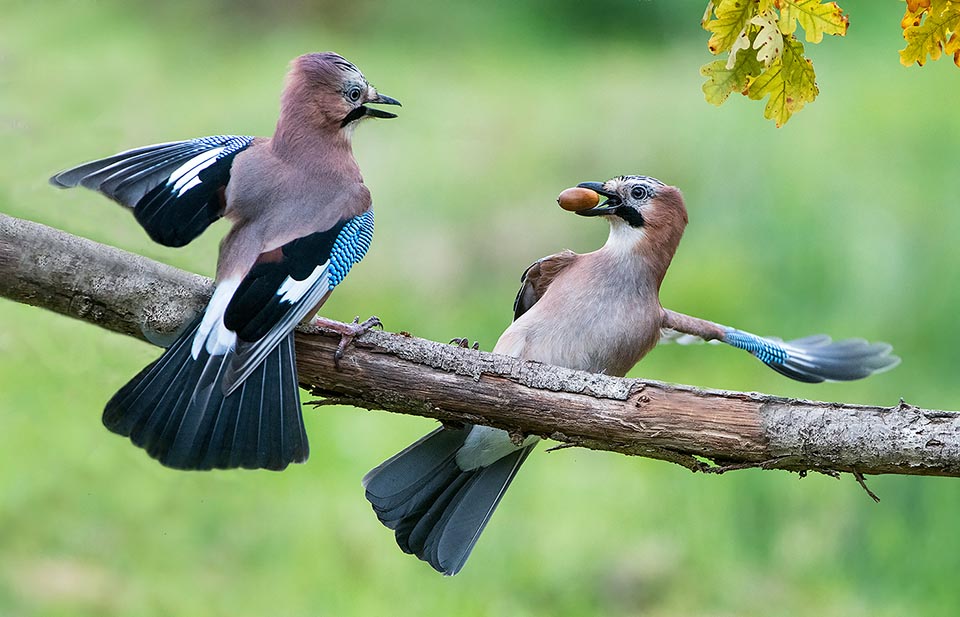
Like all corvids, overbearing and opportunists, doesn’t have a good character and even fights for one acorn © Phil Winter
The corvids display an innate wickedness, evidencing their physical strength even towards birds and animals far bigger and more fearful than them, attacking their young, killing them if the occasion arises, to then feed on them, as if they were birds of prey but also the Jay acts in the same way, obtaining the same result!
It is therefore legitimate to think that also in this case it is not the dress that makes the monk but rather that more than a nice livery, it is a disguise for rendering less tragic the above-mentioned grisly practices. It’s nature that governs these mechanisms and we, humans, can only see their evidence and nothing else. Actually, the shy and grumpy behaviour of the Jay, does not attenuate in the slightest its instinctive ferocity towards other inferior species and the opportunity is not lacking to verify their reality on many instances.
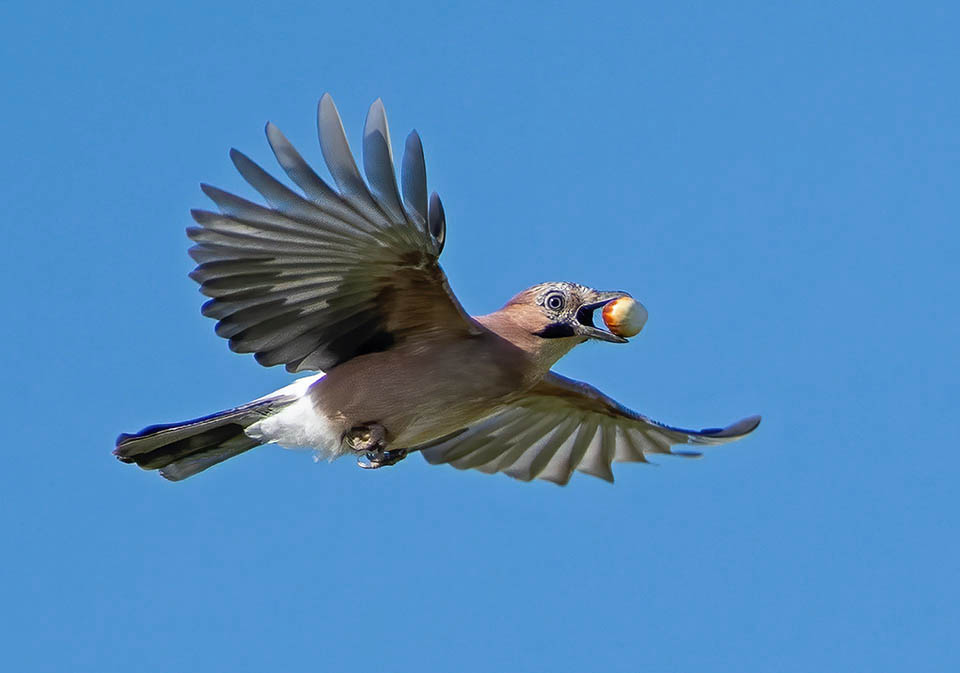
Then, selfish as it is, even if its belly is full, flies to hide it underground for when it will need it © David Smith
Look at it in the winter bird feeders: the arrival of the Jay is more feared than that of the Sparrowhawk itself! it signals its arrival beginning to blow from afar and making to flee in every corner the present small birds, the Sparrowhawk (Accipiter nisus) though very dangerous and deadly in the results, does so in silence, penetrating for a few seconds the curtain of serenity surrounding these winter feeders, to then disappear into the nothing with its sacrificial victim.
Look in the European gardens and you will see the many small birds fail to carry out their broods due to the tireless work of the Jay as well as, more, of the Magpie (Pica pica), both specialized in these domestic operations just out the door, because now they too are urbanized. The Magpie does this showing itself shamelessly to everyone, the Jay does it in a reserved way but implacable, but luckily only during the period of its nidification.
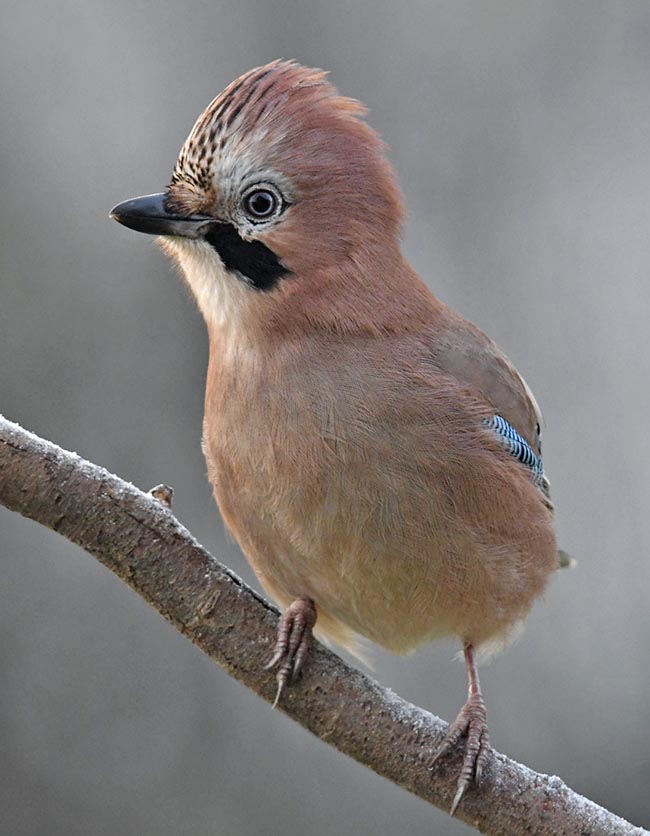
And to think it looks so cute and kind, but the dress doesn’t make the monk © Bernard Fabbro
Therefore, it is useless to try to forgive its behaviour according to the beauty of its plumage: it’s a crow, a small crow, cute and nice, but under its cheering up livery hides a cruel killer!
However, the Jay, as the Italian common name, Ghiandaia, states, is specialized in a much larger and more harmless activity than what previously cited and reveals being very often an unconscious promoter of an activity beneficial for nature that makes it partly forgiven for the just hinted misdeeds.
We do not know exactly how many acorns are handled by a Jay in autumn and how many are buried to create a winter supply.
It spends whole days in collecting them under the oaks or directly from the branches, bagging several of them into the throat, to then carry them far away and hide them in crannies of trees, under the stones, between the leaves of the underwood, burying them everywhere, ready to be recovered and eaten during the bad season but, as logically happens, many are forgotten.
Here is the best way for regenerating the forest giving birth to new seedlings that, in such a way, will colonize new sites, often very far from the mother plant.
The Jay (Garrulus glandarius Linnaeus, 1758) belongs to the order of the Passeriformes and to the family of the Corvidae, a group that includes birds scattered over all continents and with a remarkable and varied number of species.
The etymology of the scientific name highlights two properties typical of this species, already previously cited: Garrulus from the homonymous Latin term meaning chatty, sassy, boring, due to its continuous chattering and glandarius from “glans”, acorn.
The international names have various origins that make multiple references to the acorns, the oaks and to their joy: in English, for instance, Eurasian Jay, in German Eichelhäher, in Spanish Arrendajo Euroasiático, in French Geai des chênes, and in Portuguese Gaio comum.
In the local Italian dialects we find Gagia, Gaza rabosa, Gianda, Gaggia brusca, Badàscule, Glant, Gnandolla, Ghiaia and many others.
Zoogeography
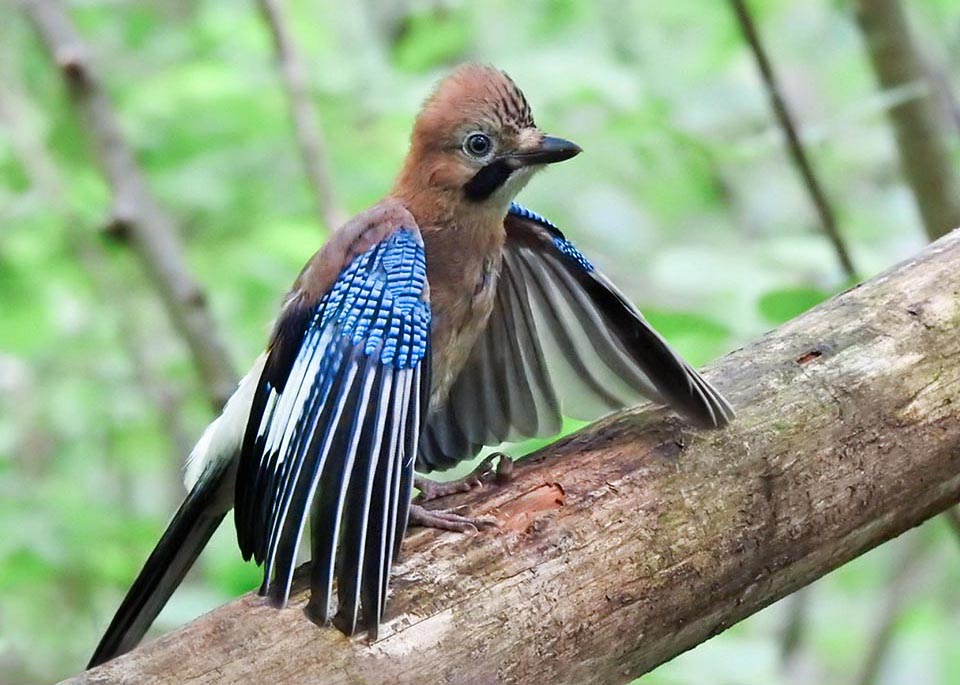
The Jay loves sunbathing wings open. Actually, this is done by many birds associating it often to the “at bathing” to care the plumage, but it practices it stubbornly, bold, destroying the anthills with its paws while it is covered by the ants who thus free it from the mites in their attacks with bites and jets of formic acid © Eero Kiuru
The Jay is a palearctic species that occupies a very vast territory including Europe totally, excluding Iceland, the extreme north of the Scandinavian peninsula and the extreme south-western part of the Iberian Peninsula. It is present in Anatolia up to the Caspian Sea and the Persian Gulf and with an uninterrupted belt padding north of the Black Sea, through Iberia, to reach the coasts of the Pacific Ocean, about at the 55th parallel, going then southwards, occupying the whole southern China, and the Indo-Malaysian peninsula. It is also present in Japan and along the entire Himalayan range. In Africa it is present in the mountainous areas of Morocco and Algeria.
The Jay is, for most of its ranges, a resident species that never abandons the place of nidification, even if subject to unfavourable situations during the bad season.
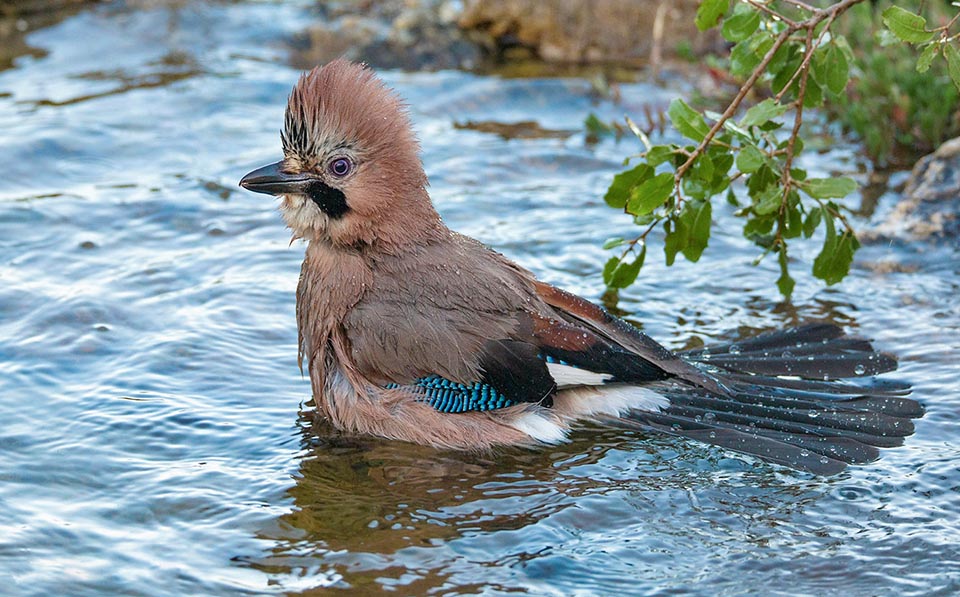
At the end the poor ants are no longer needed, and the last ones are drowned with a refreshing bath © Leoncio Hernandez Rodriguez
Nevertheless, in some areas of extreme rigour or accidentally submitted to important atmospheric worsenings, we can observe a partial and short irregular movement towards more suitable sites or further down the valleys, in the cases of mountain habitats, even if tendentially it prefers to stay in loco taking advantage of the food supplies prepared during the autumn, rather than moving in new territories and without food reserves.
Ecology-Habitat
An ideal environment for the Jays is the broad-leaves coppice or even mixed with conifers but with prevalence of essences producing acorns and palatable seeds.
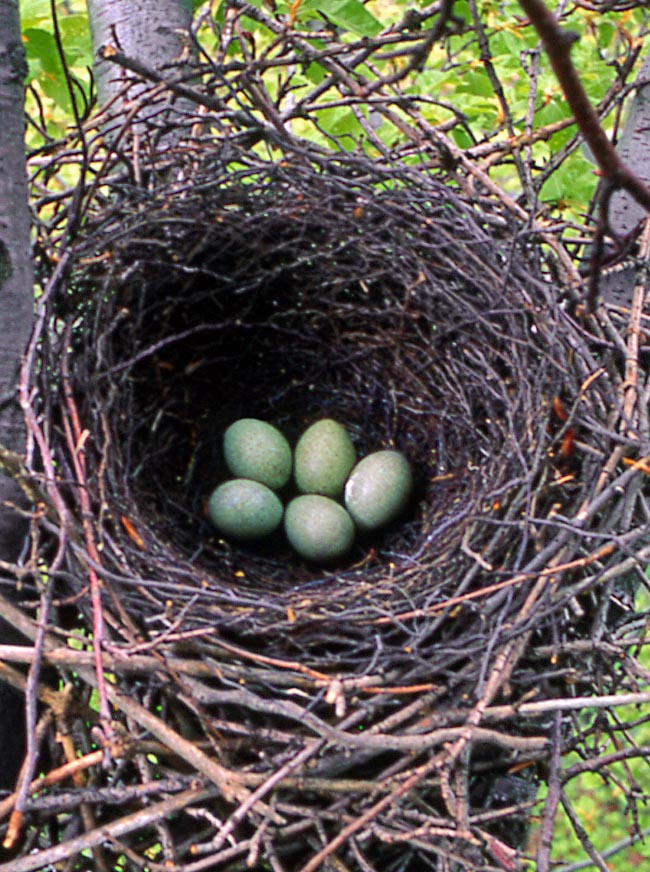
The nest, placed at 2-10 m of height, is formed by a twigs intertwining. The 4-6 eggs are hatched in turn by parents © Museo Civico di Lentate su Seveso
An open undergrowth where is easy to move and to flutter inside, keeping covered by the vault above.
In the north of its territories, it does not disdain to live in pure pine forests as well as in the south the Mediterranean thicket, displaying a strong spirit of adaptation.
As a confirmation of its reluctance, the Jay is a rather solitary bird and only occasionally, during the post nesting period, can be observed flocks of some units wandering around noisily in woods and thickets, probably formed by extended little families.
In this period, they can even abandon their woody habitats to go into cultivated fields, in orchards, in large city gardens, in elder woods with undergrowth of brambles and around the small villages in the countryside. Essential for these territorial digressions is more or less vast arboreal coverage, with rather thick shrubby undergrowths and with trees of a certain stature.
It is interesting to note that the Jay, unlike the Magpie, loves fluttering at higher altitudes and often it is seen crossing the clearing of a wood or roads or inhabited centres, keeping well high into the sky, showing a certain fear for the not – tree lined spaces below.
Morphophysiology
The Jay is a small corvid that is 35 cm long, with a weight that may reach 200 g and a wingspan of about 55 cm.
Peculiar characteristic of this nice bird is the band on the wing coverts of a bright light blue colour, crossed by narrow and elegant black lines forming a delicate checkered pattern, visible from far away from wherever it is observed. Always on the wing, then, stands another very white band, interspersed by two very black bands that, added to the previous light blue, creates a magnificent contrast when with spread wings. Also the rump is white, bordered by a well elongated and very black tail with bluish reflections. Conversely, the body is totally of a pinkish beige colour, with nuances tending to burgundy, perhaps unique among the birds of the palearctic for tonality as well as for amplitude.
Another particularity is the head, rather square and massive, that evidences large black mustaches that from the beak go down the neck for several centimetres, robust a strong beak, as a corvid, also black and by eyes with bluish grey iris and with big black pupil. Throat and front are white. On the head are present short feathers that can stand erect when the individual is excited or when dangers are present.
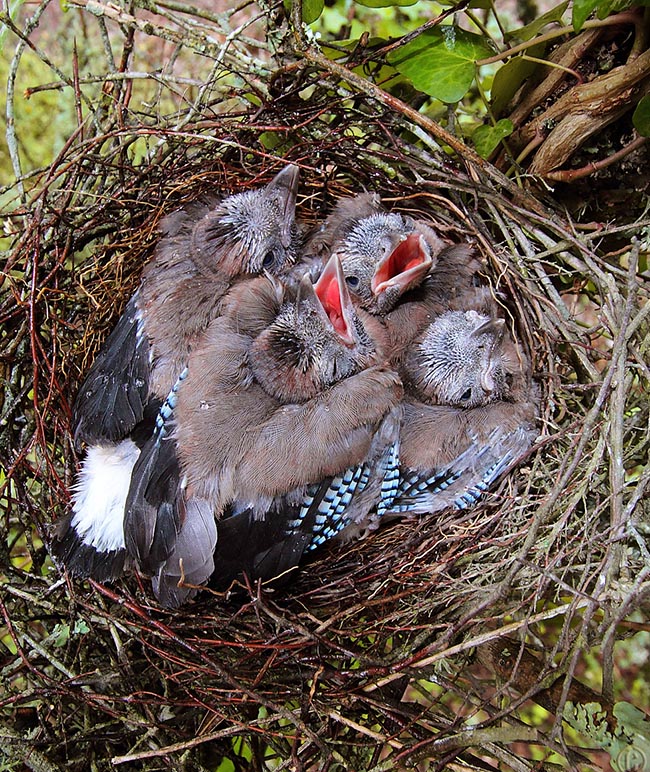
Then they feed them for about four weeks till when they leave the nest © Vitor Gonçalves
Pink flesh coloured legs tending grey, with strong nailed toes.
There is no sexual dimorphism and not even the young show immediately a plulage too distant from that of the adults.
The Jay has an infinite number of subspecies scattered in all its very vast range that often identify isolated sites, lost areas or different colour shades.
Presently, have been recognized officially more than thirty of them but it is clear that with the phylogenetic studies underway, new subspecies could add to this infinite list.
The variety is so big that in the only Europe we count at least twelve of them, among which some very localized, such as the Garrulus glandarius corsicanus for Corsica, the Garrulus glandarius ichnusae for Sardinia and the Garrulus glandarius albipectus for Sicily and for the Italian peninsula.
For the Balkan area: Garrulus glandarius graecus, Garrulus glandarius ferdinandi, Garrulus glandarius cretorum, Garrulus glandarius samios, Garrulus glandarius glaszneri.
For North Europe Garrulus glandarius hibernicus, Garrulus glandarius rufitergum, Garrulus glandarius glandarius and for the Iberian Peninsula Garrulus glandarius fasciatus.
Then there are three of them for the North Africa, four for the Middle East and about fifteen scattered in the Asian continent, of which three for the only Burma
Ethology-Reproductive Biology
A very noticeable particular in this bird is the incredible vocality it is able to express in the most different occasions.
It is able to make the sound of the Buzzard when it wants to intimidate the birds of prey, but imitates also that ot the Black kite, can warble imitating the turdids, can whistle like a marmot does, can miaow like a cat, gobble like a turkey, bubular like a tawny owl, cry like a child but there is no sound or song it is not able or it does not try to imitate.
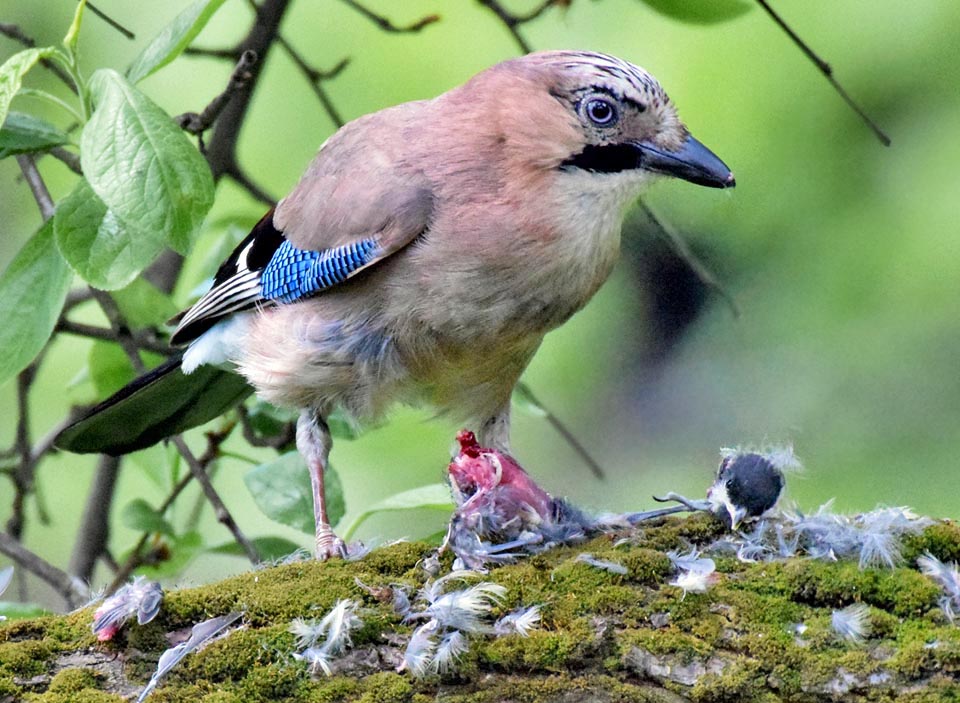
They need many proteins for growing up and the Jay attacks, pitiless, small vertebrates and the poor surrounding nestlings like this Great tit © Rafal Nalepa
Instead in the normality its song is a low chatter, a disjointed and uncoordinated whole of sobbing and croaking without the slightest melody, spaced by a blared craak craak typical to a crow, just not to forget its belonging to the same family. The couple is very faithful and probably monogamous for many seasons and therefore lives together for the entire duration of the year inside those small flocks occasionally observed.
In spring, after a short time of courting, the couple keeps even more apart in the depthes of its territory and together they build a nest formed by a platform of small twigs, grass and barks on which is modeled a rather deep cup, rendered soft by big radicles intertwined with each other. It can be placed at heights varying from two to ten metres.
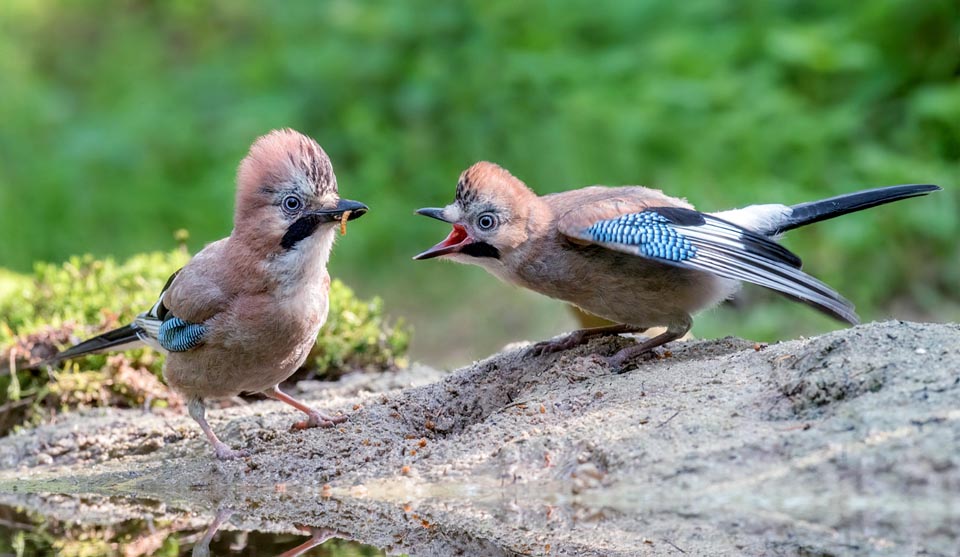
Even grown up, the young often beg for food from their parents. This young, right, still asks for beakful © Michel Roesink
4 to7 greyish light blue eggs are laid, finely spotted of reddish, rather small if compared to the size of the bird and are hatched for about 18 days, alternatively by both partners. The small nestlings stay in the nest for at least four weeks before flying off, during which both parents take care of their growth.
It is a rather touchy and instinctive bird so much to abandon definitively and without any delay its own brood even only for having passed close to the nest.
The Jay, like all corvids, is a species practically omnivorous that bases its feeding on opportunism. It is mostly carnivorous, in particular during the growing time of its kids but continues to be as such even during the whole year, eating, if the occasion arises, small rodents, reptiles and, like a skilled raider, eggs and nests of others.
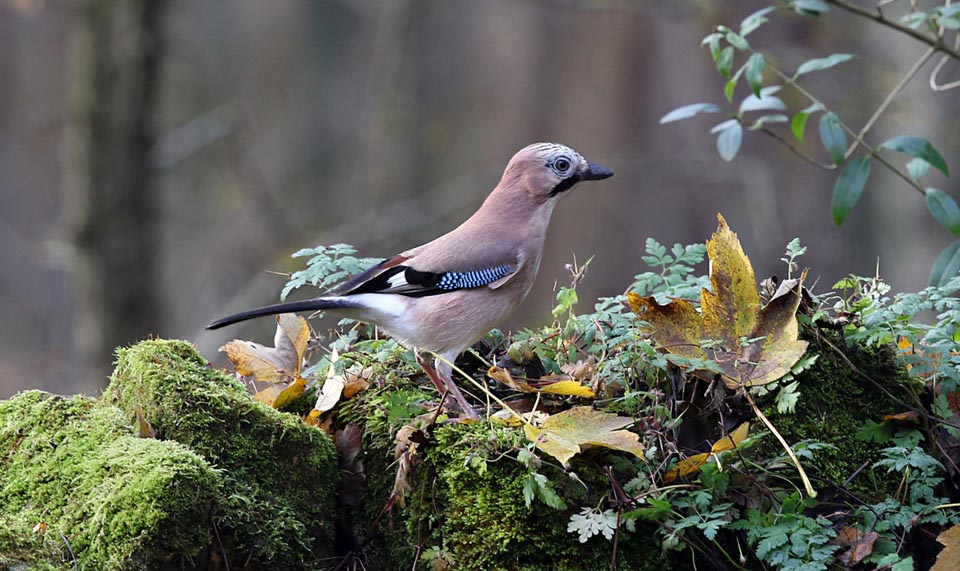
Autumn approaches: it’s the best time for collecting the acorns and find the good place where to hide the winter provisions © David Smith
It also eats larvae and insects among which also the caterpillars of the processionary, leftovers of the human activity and any other edible product that it meets during its scratching. Seeds and fruits are not missing in the good season, preferring absolutely the acorns and the beechnuts, nuts and chestnuts, hazelnuts and many types of berries but also apples, figs and persimmons are regularly included in the autumn/winter diet.
One last anecdote on this nice little crow, confirmed by the frequent observations of a strange behaviour held usually by this bird.
Let’s say first that the Jay is not the only species practicing the “ant bathing” to treat and keep healthy its plumage but this bird appears to really have a strong passion for this activity.
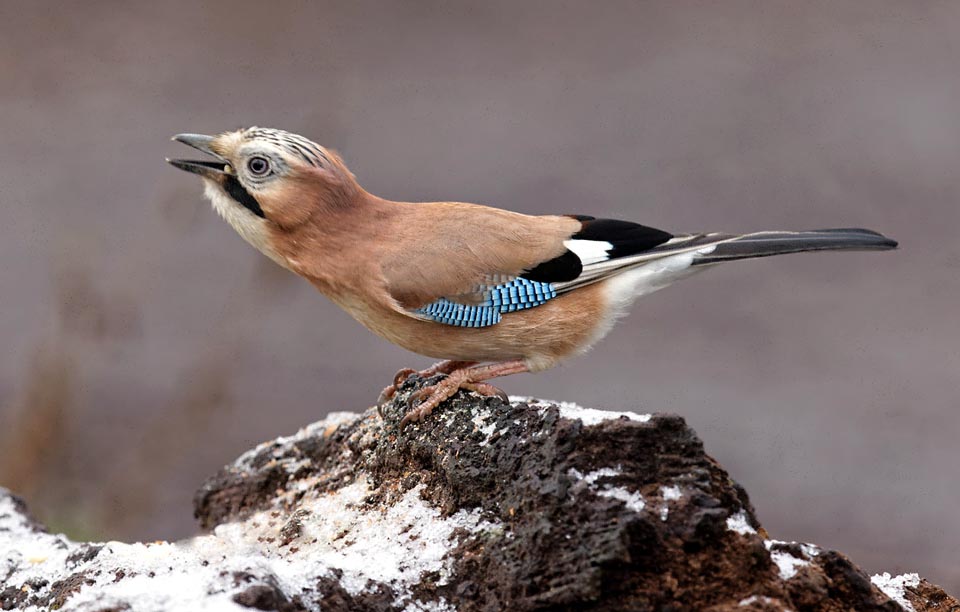
So, when snow comes the food is not lacking. The hidden provisions are easy to collect and gulps happily an acorn © Michael Hughes
It perches on an anthill, moves it with its paws exciting the ants living there and patiently waits for them to cover its whole body.
It is thought the the ants may emit, to defend against the intruder, formic acid on the feathers or that fight and catch even the mites that often infest the feathers of the birds, the fact stands that the Jay gets great benefit keeping healthy and glossy its plumage.
Synonyms
Corvus glandarius Linnaeus, 1758.
→ To appreciate the biodiversity within PASSERIFORMES please click here.
